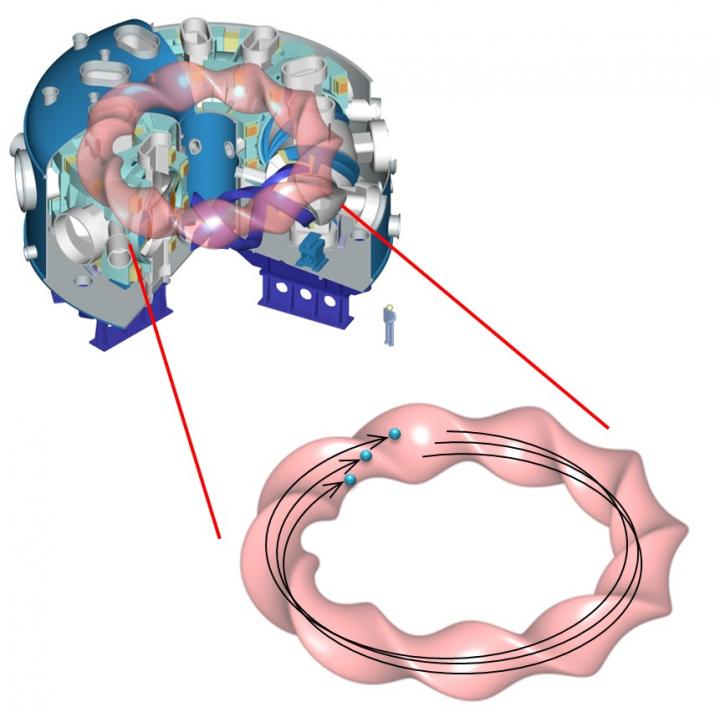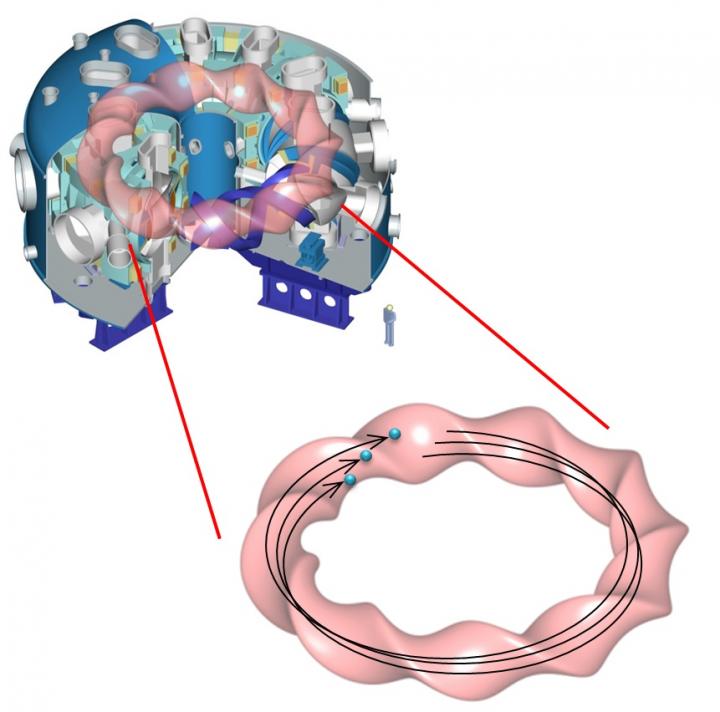
Credit: Dr. Yasushi Todo
Background to the Research High-energy alpha particles (helium ion) which are generated by the fusion reaction that uses deuterium and tritium bear the important roles of heating plasma and of maintaining the high temperature condition which is necessary for the fusion reaction. The prediction of their behavior and their control are the keys for maintaining the fusion reaction. On the other hand, to comprehend plasma, it also is a fluid that conducts electricity. And due to the flow of electric current, because the magnetic field is generated this is called magnetofluid (magnetohydrodynamic fluid). Plasmas that are magnetofluid oscillate. When such a plasma's oscillation period and the period of high-energy alpha particles circulating inside a plasma match, there is a possibility that the oscillation amplitude will increase due to resonance. As a result, because high-energy alpha particles will escape to outside the plasma, there is concern that the performance of the fusion reactor will degrade. In order to realize the generation of fusion electricity, highly reliable predictions regarding the distribution of high-energy particles that have considered the plasma's interaction with oscillations are imperative.
Research Results
The research group led by Professor Yasushi Todo and Assistant Professor Hao Wang of National Institutes of Natural Sciences National Institute for Fusion Science (NIFS) has developed a program that can simulate simultaneously the plasma behavior and the movements of high-energy particles (The program is called Hybrid Simulation because it connects fluid and particles). From this, it now has become possible to investigate in detail by simulation the interaction between plasma oscillation and high-energy particles, which was not possible by previous methods that calculated separately the plasma and the high-energy particles. Using this hybrid simulation program, on supercomputers (NIFS's plasma simulator and Helios, of the International Fusion Energy Research Centre) we conducted a large-scale simulation of the Large Helical Device (LHD) plasma. In the LHD experiments, we are advancing research on high-energy particles and plasma oscillations using high-energy particles generated by neutral beam injection (see Fig. 1). In the simulation results shown in Figure 2, together with reproducing well the experimental data for plasma oscillations that are caused by the high-energy particles, we clarified the details of oscillations which cannot be measured by experiment as well as the interaction of high-energy particles that cause the amplification of oscillation. This hybrid simulation program is appropriate not only for the LHD but also for fusion plasma experiments in Japan and abroad. By comparison with the experimental results regarding the distribution of high-energy particles and oscillations, the reliability of the program has been confirmed. Here, by successfully reproducing the LHD experiment, we have achieved the program for the first time in the world that can simulate high-energy particles and plasma oscillations.
This research result was announced at the 26th International Atomic Energy Agency conference held October 17-22 in Kyoto, Japan.
The Significance of the Research Results Using the Hybrid Simulation Program developed by the National Institute for Fusion Science, the prediction accuracy of high-energy alpha particles distribution in fusion reactor core plasma has significantly improved. This will contribute to the proposal of highly reliable operation scenario and design of the fusion reactor. Further, this will contribute to the early achievement of the fusion reactor. In addition, from these achievements our understanding of the interaction of high-energy particles and oscillations has advanced. While the oscillations of plasma cause the loss of high-energy particles that heat plasma, the oscillations by providing plasma with energy received from high-energy particles conversely heat plasma. This physical mechanism has gained the interest of researchers, and the knowledge that has been gained through this research is concealing the possibilities of becoming a basis of research.
###
Vocabulary
1. Magnetofluid model: Treating plasma as a conducting fluid, this is a physical model that describes the temporal evolution of plasma density, fluid velocity, pressure, and the electromagnetic field.
2. Hybrid simulation of high-energy particles and magnetofluid: The magnetofluid model is a superlative model that can explain the behavior of an entire plasma. In research on the interaction of high-energy particles and the oscillations of a plasma it is necessary to pursue the orbit of each high-energy particle. The hybrid simulation of high-energy particles and magnetofluid is a simulation that connects physically without contradiction the temporal evolutions of the movement of each high-energy particle and magnetofluid.
Media Contact
Dr. Yasushi Todo
[email protected]
81-572-582-245
http://www.nins.jp/english/
############
Story Source: Materials provided by Scienmag





